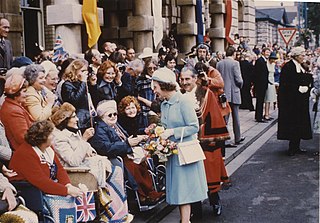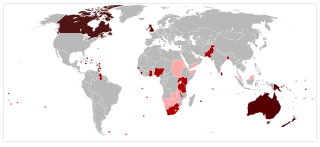 W
WThere have been 12 British monarchs since the political union of the Kingdom of England and the Kingdom of Scotland on 1 May 1707. England and Scotland had been in personal union since 24 March 1603. On 1 January 1801, the Kingdom of Great Britain and the Kingdom of Ireland merged, which resulted in the creation of the United Kingdom of Great Britain and Ireland. After 26 of Ireland's 32 counties left the union on 6 December 1922, in order to form the Irish Free State, the name of the nation was amended to the United Kingdom of Great Britain and Northern Ireland on 12 April 1927.
 W
WA royal consort is the spouse of a ruling king or queen. Consorts of monarchs in the United Kingdom and its predecessors have no constitutional status or power but many had significant influence over their spouse. Some royal consorts, such as current consort Prince Philip, Duke of Edinburgh, have also helped to enhance the image of the Monarchy by becoming celebrities in their own right. Prince Philip is the longest-serving and oldest-ever consort. His mother-in-law, Queen Elizabeth The Queen Mother, who died aged 101, lived longer but at the time of her death she did not hold the position of consort, as her husband King George VI died 50 years before her.
 W
WKing Edward VII was the monarch of the United Kingdom of Great Britain and Ireland and of the British Empire from 22 January 1901 until his death on 6 May 1910.
 W
WKing Edward VIII was the King of the United Kingdom and the Dominions and colonies of the British Commonwealth, Emperor of India, from 20 January to 11 December 1936, when he abdicated the throne.
 W
WThis is a list of places, buildings, roads and other things named after Queen Elizabeth II. It is divided by category, though each item's location is noted in the entry.
 W
WElizabeth II has held numerous titles and honours, both during and before her time as monarch of each of her Commonwealth realms. Each is listed below; where two dates are shown, the first indicates the date of receiving the title or award, and the second indicates the date of its loss or renunciation.
 W
WQueen Elizabeth II is sovereign of 16 countries informally known as the Commonwealth realms. She resides primarily in the oldest and most populous realm, the United Kingdom, and is represented in the other countries by the following viceregal representatives. She is also represented in each of the Canadian provinces, Australian states, British overseas territories and Crown dependencies, and the states in free association with New Zealand.
 W
WThe Silver Jubilee of Queen Elizabeth II marked the 25th anniversary of Queen Elizabeth II's accession to the thrones of the United Kingdom and other Commonwealth realms. It was celebrated with large-scale parties and parades throughout the United Kingdom and the Commonwealth throughout 1977, culminating in June with the official "Jubilee Days", held to coincide with the Queen's Official Birthday. The anniversary date itself was commemorated in church services across the land on 6 February 1977, and continued throughout the month. In March, preparations started for large parties in every major city of the United Kingdom, as well as for smaller ones for countless individual streets throughout the country.
 W
WThe number of states headed by Queen Elizabeth II has varied during her 68 years on the throne, altogether seeing her as sovereign of a total of 32 independent countries during this period. In her capacity as Queen of the United Kingdom, she is also monarch of three Crown dependencies—Guernsey, Jersey, and Man—and, in her capacity as Queen of New Zealand, she is monarch of two associated states—the Cook Islands and Niue—since they acquired this status in 1965 and 1974, respectively.
 W
WThis is a complete list of every known descendant of George V, the founder of the House of Windsor, and his queen Mary of Teck. The list includes deceased members, members who have become Catholic, royal and non-royal, legitimate and illegitimate members openly acknowledged by their parents. The table includes generational data and birthdays and image data. The list is more comprehensive than the line of succession to the British throne which is a list of living non-Catholic descendants of George V's sons.
 W
WKing George V was the monarch of the United Kingdom and the British Empire and its successor from 6 May 1910 until his death on 20 January 1936.
 W
WKing George VI was the monarch of the United Kingdom, the Dominions, and the British Empire from 11 December 1936 until his death on 6 February 1952.
 W
WThis is a list of the members of the British nobility and gentry, who in 1688 deserted King James II and pledged their allegiances to Prince William of Orange, as the events of the Glorious Revolution unfolded.Admiral Matthew Aylmer, who played a significant role in diverting the loyalty of the Royal Navy from King James to William of Orange. Colonel Berkley, possibly Lord Fitzharding. Captain Henry Bertie, brother of the Earl of Abingdon. Squire Bray Henry Booth, 2nd Baron Delamere, took arms in Cheshire on November 1688, appearing in Manchester with 50 armed and mounted men, which had trebled before reaching Bowden Downs. James Butler, 2nd Duke of Ormonde William Cavendish, 4th Earl of Devonshire, appeared in arms at Derby, proceeded to Nottingham, which soon became the headquarters of the Northern insurrection. John Cecil, 5th Earl of Exeter Hugh Cholmondeley, 2nd Viscount Cholmondeley, joined the northern insurrection at Nottingham in 1688, created Baron in 1689 and Earl in 1706. Charles Cokayne, 3rd Viscount Cullen Squire Coote George Compton, 4th Earl of Northampton Henry Compton, youngest son of the 2nd Earl of Northampton, Bishop of London, P.C. George Churchill (1653–1710), brother of John Churchill and captain at sea, afterwards admiral. John Churchill, Baron Churchill of Sandridge (1650–1722), deserted on 25 Nov 1688, arguably "the death-blow for the Royal Cause". Afterwards created Earl and later Duke of Marlborough and captain-general. Sir Richard Dutton, or possibly Sir Ralph Dutton, MP for Gloucester Thomas Fairfax, 5th Lord Fairfax of Cameron, MP for York. Charles Fane, 3rd Earl of Westmorland Henry FitzRoy, 1st Duke of Grafton, the first who on 24 November 1688 deserted the King's camp, accompanied by John Churchill. Charles Gerard, 1st Earl of Macclesfield, an "ancient Cavalier who had fought for Charles I, and had shared the exile of Charles II", assembled with William at the Hague in 1688. John Granville, 1st Earl of Bath, placed the fortress at Plymouth, which he commanded, at William's disposal on 18 November 1688, when William had arrived at Exeter. "The invaders therefore had now not a single enemy in their rear." Thomas Grey, 2nd Earl of Stamford Captain Griffith Sir John Guise, Baronet, MP for Gloucester Henry Hamilton-Moore, 3rd Earl of Drogheda Sir Edward Harley, Baronet, in November 1688 took up arms in Worcestershire on behalf of the Prince of Orange. Arthur Herbert, vice admiral, created Earl of Torrington in 1689. Henry Herbert, 4th Baron Herbert of Cherbury, in November 1688 took up arms in Worcestershire on behalf of the Prince of Orange. Henry Howard, 7th Duke of Norfolk, with 300 armed and mounted men, in November 1688 appeared in the market place of Norwich, where he was joined by the mayor and Alderman. Edward Hyde, Lord Cornbury (1661–1723), son of the Earl of Clarendon and one of the first royal commanders to desert. He was the senior officer at Salisbury and deserted with as many troops as he could induce to follow him. Henry Hyde, 2nd Earl of Clarendon (1638–1709), father of Lord Cornbury Robert Leke, 3rd Earl of Scarsdale John Lovelace, 3rd Baron Lovelace, set out for Exeter to join the Prince of Orange, but was taken prisoner at Gloucester. Richard Lumley seized Newcastle for William, created Viscount Lumley in 1689 and Earl of Scarborough in 1690. John Manners, 9th Earl of Rutland Squire Marle Charles Montagu, 4th Earl of Manchester, moved to Nottingham and was joined by Lord Cholmondeley and by Lord Grey de Ruthyn. Edward Osborne, Viscount Latimer, son the Earl of Danby. Peregrine Osborne, Lord Dunblane, son the Earl of Danby. Thomas Osborne, 1st Earl of Danby (1631–1712), seized York for William, was created Duke of Leeds in 1694. James Paynter, tried for and later acquitted of treason in Cornwall. Sir Robert Peyton, Baronet, colonel in the Dutch invasion Charles Powlett, Earl of Wiltshire Charles Bodvile Robartes, 2nd Earl of Radnor Richard Savage, Lord Colchester, son of Earl Rivers Charles Seymour, 6th Duke of Somerset Robert Shirley, Lord Ferrers of Chartley Philip Stanhope, 2nd Earl of Chesterfield Charles Talbot, 12th Earl of Shrewsbury Squire Tibbing, probably Squire Thomas Tipping (1653–1718), former MP for Oxfordshire who had fled to the Netherlands due to a scandal Sir John Trelawney, possibly Sir Jonathan Trelawny, 3rd Baronet Squire Trenchard (1635–1713), possibly William Trenchard of Cutteridge, Wiltshire Henry Yelverton, 15th Baron Grey de Ruthyn, joined the Northern insurrection in 1688, created Viscount de Longueville in 1690.
 W
WThe Lord High Commissioner to the General Assembly of the Church of Scotland is the Scottish Sovereign's personal representative to the General Assembly of the Church of Scotland, reflecting the Church's role as the national church of Scotland and the Sovereign's role as protector and member of that Church.
 W
WPrince Philip, Duke of Edinburgh, has received numerous titles, decorations, and honorary appointments, both during and before his time as consort to Queen Elizabeth II. Each is listed below. Where two dates are shown, the first indicates the date of receiving the title or award and the second indicates the date of its loss, renunciation or when its use was discontinued.
 W
WBritish royal residences are palaces, castles and houses occupied by members of the British royal family in the United Kingdom. Some, like Buckingham Palace and Windsor Castle, are owned by the Crown, while others like Balmoral Castle and Sandringham House are personally owned and have been passed down for generations. Some royal palaces, such as the Palace of Westminster are no longer residences. Some remain in irregular use for royal occasions, such as Hillsborough Castle in Northern Ireland.
 W
WThis is a list of present and past Royal Warrant holders of the British Royal Family.
 W
WThis is a list of statues of British royalty in London.
 W
WQueen Victoria was the monarch of the United Kingdom of Great Britain and Ireland and of the British Empire from 20 June 1837 until her death on 22 January 1901. At the start of her reign, responsible government outside of the United Kingdom itself was unknown, but starting in the 1840s this would change.
 W
WThis is a list of royal yachts of the United Kingdom. There have been 84 royal yachts since the restoration of the monarchy in 1660. King Charles II had 25 royal yachts and five were simultaneously in service in 1831. Occasionally merchantmen or warships have been chartered or assigned for special duty as a temporary royal yacht, for example the steamship Ophir in 1901 and the battleship HMS Vanguard in 1947. In 1997 HMY Britannia was decommissioned and not replaced. Since 1998, following a successful national tender process, the Royal Yacht Britannia has been berthed permanently at the Port of Leith in Edinburgh. There are currently no British royal yachts, although MV Hebridean Princess has been used by the Royal Family.